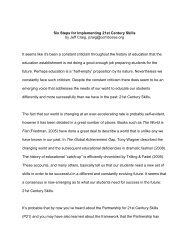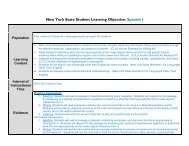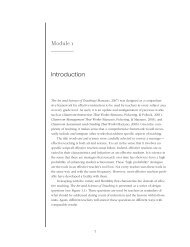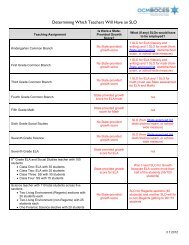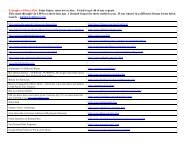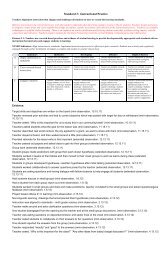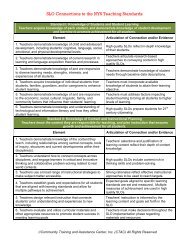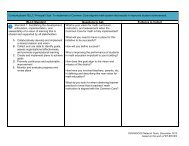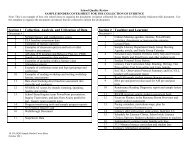New York State Student Learning Objective: Music 5th ... - OCM Boces
New York State Student Learning Objective: Music 5th ... - OCM Boces
New York State Student Learning Objective: Music 5th ... - OCM Boces
Create successful ePaper yourself
Turn your PDF publications into a flip-book with our unique Google optimized e-Paper software.
<strong>New</strong> <strong>York</strong> <strong>State</strong> <strong>Student</strong> <strong>Learning</strong> <strong>Objective</strong>: <strong>Music</strong> 5 th Grade<br />
All SLOs MUST include the following basic components:<br />
Population<br />
These are the students assigned to the course section(s) in this SLO - all students who are assigned to the course section(s) must be included in the<br />
SLO. (Full class rosters of all students must be provided for all included course sections.<br />
5 th Grade General <strong>Music</strong> – 2 sections, 48 students<br />
What is being taught over the instructional period covered? Common Core/National/<strong>State</strong> standards? Will this goal apply to all standards<br />
applicable to a course or just to specific priority standards?<br />
Nat’l Standard of <strong>Music</strong> Education #1 – Singing, alone and with others, a varied repertoire of music<br />
<strong>Learning</strong><br />
Content<br />
Nat’l Standard of <strong>Music</strong> Education #2 – Performing on instruments, alone and with others, a varied repertoire of music<br />
Nat’l Standard of <strong>Music</strong> Education #6 – Listening to, analyzing, and describing music<br />
Using the tonal syllables of the C major scale, students will learn to sing an 8-16 measure melody, as well as a harmony line<br />
based on thirds to accompany the melody. <strong>Student</strong>s will transfer the melody and harmony line to instruments with accuracy and<br />
independence.<br />
Interval of<br />
Instructional<br />
Time<br />
What is the instructional period covered (if not a year, rationale for semester/quarter/etc)?<br />
2012-2013 school year<br />
What specific assessment(s) will be used to measure this goal? The assessment must align to the learning content of the course.<br />
Evidence<br />
Baseline assessment: <strong>Student</strong>s will sing and play 3-5 note melodic echo patterns using tonic and dominant scale tones in the<br />
key of C major. <strong>Student</strong>s will accurately play a 4-8 measure single line melody on xylophones by transferring their knowledge of<br />
melody attributes of directionality, tonic, steps and skips, 8 note major scale and the intervallic relationships using tonal solfege<br />
syllables. Each task will be assessed with a common performance rubric (see below).<br />
Summative Assessment: <strong>Student</strong>s will use melodic understandings to transfer an 8-16 measure melody in the key of C major on<br />
to a tonal instrument. They will also learn to sing a harmony line in 3rds and transfer that onto a tonal instrument in<br />
performance. <strong>Student</strong>s will demonstrate learning content, and will be assessed with a common 20-point performance rubric.
<strong>New</strong> <strong>York</strong> <strong>State</strong> <strong>Student</strong> <strong>Learning</strong> <strong>Objective</strong>: <strong>Music</strong> 5 th Grade<br />
What is the starting level of students’ knowledge of the learning content at the beginning of the instructional period?<br />
Level 4 (Mastery): 10<br />
Baseline<br />
Level 3 (Competent): 23<br />
Level 2 (Developing): 7<br />
Level 1 (Still Working): 8<br />
Target(s)<br />
What is the expected outcome (target) of students’ level of knowledge of the learning content at the end of the instructional period?<br />
80% of students will score 15 points or higher on summative assessment of 20 points.<br />
How will evaluators determine what range of student performance “meets” the goal (effective) versus “well-below” (ineffective), “below”<br />
(developing), and “well-above” (highly effective)?<br />
See ranges as specified (based on baseline data and district history).<br />
HEDI Scoring<br />
HIGHLY<br />
EFFECTIVE<br />
EFFECTIVE DEVELOPING INEFFECTIVE<br />
20 19 18 17 16 15 14 13 12 11 10 9 8 7 6 5 4 3 2 1 0<br />
99-<br />
100<br />
%<br />
97-<br />
98%<br />
95-<br />
96%<br />
92-<br />
94%<br />
88-<br />
91%<br />
85-<br />
87%<br />
82-<br />
84%<br />
79-<br />
81%<br />
76-<br />
78%<br />
73-<br />
75%<br />
Describe the reasoning behind the choices regarding learning content, evidence, and target and how they will be used together to prepare<br />
students for future growth and development in subsequent grades/courses, as well as college and career readiness.<br />
71-<br />
72%<br />
68-<br />
70%<br />
64-<br />
67%<br />
60-<br />
63%<br />
57-<br />
59%<br />
53-<br />
56%<br />
49-<br />
52%<br />
45-<br />
48%<br />
40-<br />
44%<br />
30-<br />
39%<br />
<strong>New</strong> <strong>York</strong> <strong>State</strong> <strong>Student</strong> <strong>Learning</strong> <strong>Objective</strong>: <strong>Music</strong> 5 th Grade<br />
Level 4<br />
Level 3<br />
Level 2<br />
Level 1<br />
Mastery<br />
Competent<br />
Developing<br />
Still Working<br />
<strong>Student</strong> plays all 10 melodic<br />
patterns with accuracy up to two<br />
errors.<br />
<strong>Student</strong> plays all 10 melodic patterns<br />
with 3-4 errors.<br />
<strong>Student</strong> plays all 10 melodic patterns<br />
with<br />
5-6 errors.<br />
<strong>Student</strong> plays all 10 melodic<br />
patterns with more than 6 errors.<br />
<strong>Student</strong> demonstrates knowledge<br />
of tonic, directionality, steps,<br />
skips, and repeated notes<br />
independently.<br />
<strong>Student</strong> demonstrates knowledge of<br />
tonic, directionality, steps and skips<br />
and repeated notes on most patterns.<br />
May have trouble with patterns with<br />
wider intervals.<br />
<strong>Student</strong> demonstrates knowledge of<br />
tonic, directionality and step motion. Has<br />
not mastered patterns with intervallic<br />
skips.<br />
<strong>Student</strong> demonstrates knowledge of<br />
tonic. <strong>Student</strong> still working on<br />
directionality of pitch.<br />
<strong>Student</strong> transfers known melody<br />
to xylophone using syllables as a<br />
melodic too. <strong>Student</strong> plays with<br />
accuracy of up to 2 errors.<br />
Demonstrates knowledge of<br />
melodic attributes sated above,<br />
independently within an ensemble<br />
setting.<br />
<strong>Student</strong> transfers known melody to<br />
xylophone using syllables as a melodic<br />
tool. <strong>Student</strong> plays melody with up to<br />
3-5 mistakes that signify a lack of<br />
understanding linking melodic<br />
components.<br />
<strong>Student</strong> transfers known melody to<br />
xylophone using syllables as melodic<br />
tool. <strong>Student</strong> plays melody with up to 6-8<br />
errors that may signify a lack of<br />
understanding linking melodic<br />
components and/or finding certain<br />
melody tones.<br />
<strong>Student</strong> transfers known melody to<br />
xylophone using syllables as a<br />
melodic tool. <strong>Student</strong> plays melody<br />
with 9 or more errors. <strong>Student</strong><br />
needs more support and<br />
understanding of melodic patterns<br />
that combine to create a melody.



